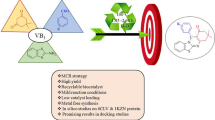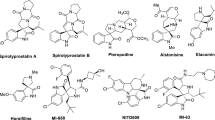Abstract
4-Quinolones compose a remarkable class of compounds that show various pharmacological applications. In particular, the activities of both (S) and (R) enantiomers of 2-aryl-2,3-dihydro-4(1H)-quinolones have made them an object of befitting interest for asymmetric synthesis. Although readily yielded as a racemic mixture from an one-pot reaction between 2-aminoacetophenone and benzaldehyde, a pathway for the metal-free enantioselective one-pot synthesis of the (S) isomer is not completely clear. In the present work, guided by the burgeoning role of organocatalysis in asymmetric synthesis and recent experimental insight into the most likely reaction mechanism, we report the in silico screening for a roster of MacMillan chiral imidazolidinones through quantum mechanics calculations. Two stereopredictive models yielding similarly high expected ee (up to 97%) were proposed. The role of aromatic interactions for the control of enantioselectivity was systemically studied, as well as the Pro-S si-enantiofacial attack activation energies, which were found to correlate well (R2 = 0.75) with the reported Bürgi-Dunitz angle for the expected intramolecular Mannich reaction mechanism.
Graphical abstract












Similar content being viewed by others
Data availability
Not applicable.
Code availability
Not applicable.
References
Bheemanapalli LN, Kaur A, Arora R, Sangeeta RRA, Javali NM (2012) Synthesis, evaluation of 6,8-dibromo-2-aryl-2,3-dihydroquinolin-4(1H)-ones in MCF-7 (breast cancer) cell lines and their docking studies. Med Chem Res 72:1741–1750. https://doi.org/10.1007/s00044-011-9688-z
Kawaii S, Endo K, Tokiwano Y (2012) Relationship between structure and antiproliferative activity of 1-azaflavanones. Anticancer Res 32:2819–2825
Xia Y, Yang Z, Xia P, Bastow KF, Tachibana Y, Kuo SC, Hamel E, Hackl T, Lee KH (1998) Antitumor agents. 181. Synthesis and biological evaluation of 6,7,2,3,4-substituted-1,2,3,4-tetrahydro-2-phenyl-4-quinolones as a new class of antimitotic antitumor agents. J Med Chem 41:1155–1162. https://doi.org/10.1021/jm9707479
Pinheiro S, Muri EMF, Oliveira RPRF, Dias LRS, Greco SJ (2017) Asymmetric catalysis in the synthesis of azaflavanones. Mini Reviews in Organic Chemistry 5:400–406. https://doi.org/10.2174/1570193X14666170518120501
Zheng H, Liu Q, Wen S, Yang H, Luo Y (2013) One-pot asymmetric synthesis of 2-aryl-2,3-dihydro-4-quinolones catalyzed by amino acid-derived sulfonamides. Tetrahedron: Asymmetry 24:875–882. https://doi.org/10.1016/j.tetasy.2013.05.028
Pan GF, Su L, Zhang YL, Guo SH, Wang YQ (2016) Organocatalytic one-pot asymmetric synthesis of 2-aryl-2,3-dihydro-4-quinolones. Royal Society of Chemistry Advances 6:25375–25378. https://doi.org/10.1039/C6RA01247G
MacMillan CWD, Borths JC, Ahrendt AK (2000) New strategies for organic catalysis: the first highly enantioselective organocatalytic Diels-Alder reaction. Journal of American Chemical Society 122:101–4244. https://doi.org/10.1021/ja000092s
Houk KN, Ölçüm N, Um MJ, Legault C, Cheong P (2011) Quantum mechanical investigations of organocatalysis: mechanisms, reactivities, and selectivities. Chem Rev 111:5042–5137. https://doi.org/10.1021/cr100212h
List B, Seayad J (2011) Asymmetric organocatalysis. Org Biomol Chem 111:5042–5137. https://doi.org/10.1039/B415217B
Bickelhaupt FM, Hamlin AT, Fernández I (2021) The Pauli repulsion-lowering concept in catalysis. Acc Chem res 54:1972–1981. https://doi.org/10.1021/acs.accounts.1c00016
Macmillan WCD, Paras AN (2001) New strategies in organic catalysis: the first enantioselective organocatalytic Friedel-Crafts alkylation. J Am Chem Soc 123(18):4370–4371. https://doi.org/10.1021/ja015717g
Macmillan WCD, Larsen HC (2001) Enantioselective organo-cascade catalysis. J Am Chem Soc 127(43):15051–15053. https://doi.org/10.1021/ja055545d
Macmillan WCD, Northrup BA (2002) The first direct and enantioselective cross-aldol reaction of aldehydes. J Am Chem Soc 124(24):6798–6799. https://doi.org/10.1021/ja0262378
Goodman MJ, Simón L (2011) How reliable are DFT transition structures? Comparison of GGA, hybrid-meta-GGA and meta-GGA functionals. Org Biomol Chem 9:689–700. https://doi.org/10.1039/C0OB00477D
Wheeler ES, Guan Y, Ingman MV, Rooks JB (2018) AARON: an automated reaction optimizer for new catalysts. J Chem Theory Comput 5249–5261 https://doi.org/10.1021/acs.jctc.8b00578
Truhlar DG, Schultz EN, Zhao Y (2005) Exchange-correlation functional with broad accuracy for metallic and nonmetallic compounds, kinetics, and noncovalent interactions. J Chem Phys 123:161103. https://doi.org/10.1063/1.2126975
Krenske HE (2013) Aromatic interactions in asymmetric catalysis: control of enantioselectivity in Diels-Alder reactions catalyzed by camphor-derived hydrazides. Org Biomol Chem 11:5226–5232. https://doi.org/10.1039/C3OB40850G
Houk KN, Krenske HE (2013) Aromatic interactions as control elements in stereoselective organic reactions. Acc Chem Res 46(4):979–989. https://doi.org/10.1021/ar3000794
Sherrill D, Chill TS, Hohenstein GE (2008) Assessment of the performance of the M05–2X and M06–2X exchange-correlation functions for noncovalent interactions in biomolecules. J Chem Theory Comput 4:1996–2000. https://doi.org/10.1021/ct800308k
Wertz D (1980) Relationship between the gas-phase entropies of molecules and their entropies of solvation in water and 1-octanol. J Am Chem Soc, 5316–5322 https://doi.org/10.1021/ja00536a033
Harvey JN, Maseras FP, Scope L (2019) Scope and challenge of computational methods for studying mechanism and reactivity in homogeneous catalysis. ACS Catal 9(8):6803–6813. https://doi.org/10.1021/acscatal.9b01537
Gaussian 09, Revision D.01, Frisch MJ, Trucks GW, Schlegel HB, Scuseria GE, Robb MA, Cheeseman JR, Scalmani G, Barone V, Petersson GA, Nakatsuji H, Li X, Caricato M, Marenich A, Bloino J, Janesko BG, Gomperts R, Mennucci B, Hratchian HP, Ortiz JV, Izmaylov AF, Sonnenberg JL, Williams-Young D, Ding F, Lipparini F, Egidi F, Goings J, Peng B, Petrone A, Henderson T, Ranasinghe D, Zakrzewski VG, Gao J, Rega N, Zheng G, Liang W, Hada M, Ehara M, Toyota K, Fukuda R, Hasegawa J, Ishida M, Nakajima T, Honda Y, Kitao O, Nakai H, Vreven T, Throssell K, Montgomery JA Jr, Peralta JE, Ogliaro F, Bearpark M, Heyd JJ, Brothers E, Kudin KN, Staroverov VN, Keith T, Kobayashi R, Normand J, Raghavachari K, Rendell A, Burant JC, Iyengar SS, Tomasi J, Cossi M, Millam JM, Klene M, Adamo C, Cammi R, Ochterski JW, Martin RL, Morokuma K, Farkas O, Foresman JB, Fox DJ, Gaussian, Inc., Wallingford CT
List B, Pojarliev P, Biller TW, Martin JH (2002) The proline-catalyzed direct asymmetric three-component Mannich reaction: scope, optimization, and application to the highly enantioselective synthesis of 1,2-amino alcohols. J Am Chem Soc 124(5):827–833. https://doi.org/10.1021/ja0174231
Kessler H (1974) Thermal isomerization around double bonds. Rotation and inversion. Tetrahedron 30:1861–1870. https://doi.org/10.1016/S0040-4020(01)97319-3
List B (2001) Asymmetric aminocatalysys. Synlett 11:1675–1686. https://doi.org/10.1055/s-2001-18074
Gan L, Zhou J, Chang Q (2011) Theoretical study on the mechanisms of proline-catalyzed Mannich reaction between acetaldehyde and n-boc imines. J Phys Org Chem 667–673 https://doi.org/10.1002/poc.2898
Chandrasekhar S, Vijeender K, Sridhar C (2007) L-proline-catalyzed one-pot synthesis of 2-aryl-2,3-dihydroquilin-4(1h)-ones. Tetrahedron Lett 48:1972–1981. https://doi.org/10.1016/j.tetlet.2007.05.028
List HKNB, H MJ, Bahmanyar S (2003) Quantum mechanical pre- dictions of the stereoselectivities of the proline-catalyzed asymmetric intermolecular aldol reactions. J Am Chem Soc 125:2475–2479. https://doi.org/10.1021/ja028812d
Armstrong A, Boto AR, Dingwall P, Contreras-García J, M HJ, Mason JN, Rzepa SH (2014) The Houk-List transition states for organocatalytic mechanisms revisited. Chem Sci, 2057–2071 https://doi.org/10.1039/C3SC53416B
Suresh HC, Ajitha JM (2011) Role of stereoelectronic features of imine and enamine in (S)-proline catalyzed Mannich reaction of acetaldehyde: an in silico study. J Comput Chem 32(9):1962–1970. https://doi.org/10.1002/jcc.21780
Anslyn VE, Dougherty AD (2006) Modern physical organic chemistry vol. 1, 2nd edn., pp. 391–397. University Science Books, USA https://doi.org/10.1002/anie.200585348
Hammar P (2008) Quantum chemical studies of enantioselective organocat alytic reactions, 1st edn. Royal Institute of Technology, Sweden https://doi.org/10.1002/anie.200700916
Gernot F, Hopffgarten VM (2011) Energy decomposition analysis. WIREs Comput Mol Sci 2(1):1345. https://doi.org/10.1002/wcms.1345
Sanders KMJ, Hunter AC (1990) The nature of π-π interactions. J Am Chem Soc 112:5525–5534. https://doi.org/10.1021/ja00170a016
Wheeler ES (2013) Understanding substituent effects in noncovalent interactions involving aromatic rings. Acc Chem Res 46(4):1029–1038. https://doi.org/10.1021/ar300109n
Macmillan WCD, Lelais G (2006) Modern strategies in organic catalysis: the advent and development of iminium activation. Aldrichimica Acta 39(3):315–362. https://doi.org/10.1016/S0065-3160(06)41006-6
Acknowledgements
The authors are thankful to the datacenter OSCAR of Universidade Federal Fluminense (UFF), where the theoretical calculations were performed. The authors are grateful to CAPES (Coordenação de Aperfeiçoamento de Pessoal de Nível Superior), CNPq (Conselho Nacional de Desenvolvimento Científico e Tecnológico), and FAPERJ (Fundação Carlos Chagas Filho de Amparo à Pesquisa do Estado do Rio de Janeiro, E-26/211.517/2021) for funding this research project. We are grateful to former and current coworkers, friends, and acquaintances for their intellectual contributions to the research in our laboratory.
Funding
FAPERJ (Fundação Carlos Chagas Filho de Amparo à Pesquisa do Estado do Rio de Janeiro), E-26/211.517/2021.
Author information
Authors and Affiliations
Contributions
PLLR drafted the manuscript, carried out the calculations and data analysis. FMS participated in the research coordination and review of the manuscript. SP conceived of the study and took part in the drafting and review of the manuscript, as well as in the preparation of artwork. RGF coordinated this research, took part in the drafting and review of the manuscript, as well as in the preparation of artwork. The authors read and approved the final manuscript.
Corresponding authors
Ethics declarations
Ethics approval
Not applicable.
Consent for publication
The authors have consented to the publication.
Conflict of interest
The authors declare no competing interests.
Additional information
Publisher's note
Springer Nature remains neutral with regard to jurisdictional claims in published maps and institutional affiliations.
This paper belongs to Topical Collection XXI-Brazilian Symposium of Theoretical Chemistry (SBQT2021).
Supplementary Information
Below is the link to the electronic supplementary material.
Rights and permissions
Springer Nature or its licensor (e.g. a society or other partner) holds exclusive rights to this article under a publishing agreement with the author(s) or other rightsholder(s); author self-archiving of the accepted manuscript version of this article is solely governed by the terms of such publishing agreement and applicable law.
About this article
Cite this article
de Lima Lopes Rocha, P., dos Santos, F. ., Pinheiro, S. et al. Noncovalent interactions as a solution for the metal-free one-pot asymmetric synthesis of (S)-2-aryl-2,3-dihydro-4(1H)-quinolones. J Mol Model 28, 369 (2022). https://doi.org/10.1007/s00894-022-05361-y
Received:
Accepted:
Published:
DOI: https://doi.org/10.1007/s00894-022-05361-y




